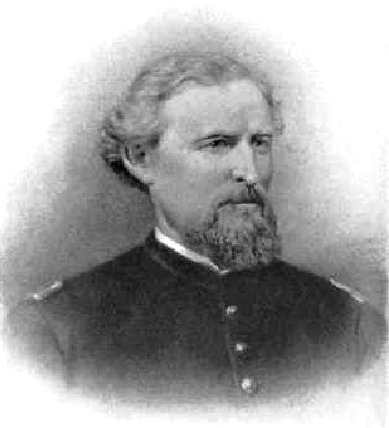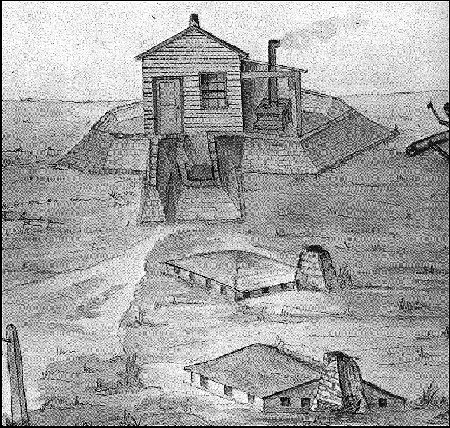According to Cope (1875, p. 166), the type specimen of Tylosaurus proriger (Harvard MCZ 4374) was discovered near Monument Rocks in Logan Countyby "Col. Connyngham [sic] and Mr. Minor," and was acquired by Professor Louis Agassiz during his August 1868 visit to western Kansas (Cope, 1869, 1870, 1875; Williston, 1898; Russell, 1967; Everhart, 2005). It was the first mosasaur to be described from Kansas and was originally named “Macrosaurus” proriger by Cope.
EDITOR'S NOTE: For the record, Cope mis-spelled the name of the person who discovered Tylosaurus proriger. His full name was John Butler Conyngham (1827-1871), an Army Captain, commanding Company I of the 38th Infantry Regiment at the time of the discovery. Conyngham was a practicing attorney in Wilkes-Barre, Pennsylvania when he joined the Army at the start of the Civil War. He attained the rank of Brevet Colonel in 1865 while in command of the 52nd Regiment of Pennsylvania Volunteers, and served as the commander until the unit was mustered out in July 1865.
 |
After the war, he rejoined the Army, was appointed a Captain
in the 38th U.S. Infantry Regiment and then was assigned to Kansas. He assumed
military command of "Fort Monument," a stagecoach station along
the Butterfield
Overland Trail in August, 1867, and on orders from
the Army, he moved his troops 35 miles northwest to Antelope Station (now Monument, Kansas)
on the Union Pacific Railroad on June 24, 1868. While serving with the 38th Infantry at Fort Clark,
Texas, he contracted Bright's disease [kidney failure] and returned to the
family home in Pennsylvania. He died on May 27, 1871 in
Wilkes-Barre, Pennsylvania and is buried there.
FIND A GRAVE MEMORIAL TO COL. JOHN BUTLER CONYNGHAM During the summer of 1868, Louis Agassiz traveled through the Great Plains, including Kansas, with a group of businessmen and congressmen. When he reached the end of the Kansas Pacific Railroad near Sheridan, Kansas, he may have met Capt. Conyngham who was then stationed in the town of Monument, Kansas. It is likely that Conyngham showed the fossil specimen to Agassiz and either gave it to him or arranged to send it to him at Harvard. Cope saw photos of the specimen at the December 22, 1868 ANSP meeting and borrowed it from Agassiz at Harvard. Cope then briefly described and named it orally at the June 1, 1869 meeting of the ANSP. LEFT: Colonel John Butler Conyngham, Commander, 52nd Regiment, Pennsylvania Volunteers, 1862-1865. RIGHT: Sketch of the only wooden building at Fort Monument as drawn by Pvt. J. Stadler, 5th Infantry Regiment. It served as the headquarters for the Army, and living quarters and eating area for the stage company employees and passengers. The troops lived in dug-outs shown in the foreground. (adapted from Lee, 1980). The fort was located a little south and about a mile west of Monument Rocks, on the north side the Smoky Hill River. The move to the town of Monument apparently wasn't a big improvement in the living conditions: A newspaper description of the town of Monument in the Topeka Weekly Leader(Anonymous, 1868) does not paint a pretty picture of the living conditions at the time: "There are twenty cloth houses at Monument, besides the quarters tents [U.S. Army] . . . [f]our saloons, two fruit stands, one boarding house and news depot and post office. At Monument is a level plain as far as the eye can reach on either side. Twelve miles westward is Sheridan, and yet seventeen further and you reach Fort Wallace, where Harrison Nichols keeps hotel. We'd soon be in mid ocean in a wash-tub as in the centre of these plains on foot." |
 |
The original description of the new species was made orally by Cope at the June 1, 1869 meeting of the Academy of Natural Sciences of Philadelphia (ANSP) and transcribed into the Proceedings,. It was extremely brief by modern standards (below).
|
Natural Sciences of Philadelphia 123
June 1st, The President, Dr. Hays, in the Chair. Twenty-one members present.
“Prof. Cope exhibited some specimens of extinct reptiles of interest. …” …………….. “He made some remarks on a fine fragment of the muzzle of a large Mosasauroid, which pertained to a cranium of near five feet in length. The pterygoid bones were separated from each other, and support nine teeth. A peculiarity of physiognomy was produced by the cylindric prolongation of the premaxillary bone beyond the teeth, and a similar flat prolongation of the extremity of the dentary. He referred the species to Macrosaurus Owen, under the name M. proriger. The specimen he stated belonged to Prof. Agassiz, who obtained it from Western Kansas, probably from the No. 3 of the Upper Cretaceous [Niobrara Fm.] of Hayden.” |
Naming the first mosasaur from Kansas
The species name (Macrosaurus” proriger) was referred to by Joseph Leidy in the Proceedings of the ANSP on January 4 and January 11, 1870.
Cope
(1870, pl. 12, figs 22, 23) described the same specimen more completely, figured
it and, with little explanation, referred it to another European genus, LiodonOwen. Two years later, O.C. Marsh, apparently recognizing significant
differences between the American and European mosasaurs, proposed a new genus (Rhinosaurus:
meaning nose-lizard) from a more complete specimen (YPM 1268 - Rhinosaurus
micromus) he had collected ‘on the south side of the Smoky Hill River’
in 1871. However, that name was preoccupied and Cope (1872) proposed the genus
name Rhamphosaurus. In
a brief note, Marsh (1872, p. 147) wrote that:
“As this name [Rhinosaurus] proves to be preoccupied, it may be replaced with Tylosaurus. The name Rhamphosaurus, since suggested by Prof. Cope, cannot be retained, as it was given to a genus of lizards in 1843 by Fitzinger.” Leidy (1873, p. 274) was the first to place ‘Macrosaurus’ proriger Cope, 1869 into Tylosaurus Marsh.
That said, Cope didn't give up.... In Cope's "Review of the Vertebrata" paper (1874, p. 36), he wrote this disclaimer as part of his description of a new species, Rhamphosaurus (Tylosaurus)nepaeolicus: "This name was applied by Fitzinger to two species of lizards, which had already received several generic names, and hence became at once a synonym. Further, he did not characterize it; for these reasons the name was not preoccupied at the time I employed it as above; hence there is no necessity for Prof. Marsh's subsequent name Tylosaurus, given on the supposition of preoccupation."
However, Marsh's name was accepted. A third
species from the Smoky Hill Chalk (Tylosaurus
kansasensis) was named by Everhart (2005). Several other
tylosaurine mosasaurs have been described from around the world, including
Antarctica.
References:
Cope, E.D. 1869. [Remarks on Holops brevispinus,Ornithotarsus immanis, and Macrosaurus proriger.]
Proceedings of the Academy of Natural Sciences of Philadelphia, 11(81):123
(meeting of June 1, 1869)
Cope, E.D. 1869. [Report of the June 1, 1869 meeting of the
Academy of Natural Sciences of Philadelphia - Cope report on Cretaceous reptiles
of New Jersey]. Nature, 1:121-122.
Cope, E.D. 1870. Synopsis of the extinct Batrachia and
Reptilia of North America. Transactions American Philosophical Society, (n. s.)
14:1-252 + i-viii, 55 figs., 14 pl. (*Revision of Cope, 1869, same title, with
publication dated listed as August, 1869, published after March, 1870)
Cope, E.D. 1872. [On the structure of the Pythonomorpha]. Proceedings of the Academy of Natural Sciences of Philadelphia 24:140-141. (meeting of June 11)
Cope, E.D. 1875. The Vertebrata of the Cretaceous formations of the West. Report, U. S. Geological Survey Territories (Hayden). 2:302 p, 57 pls.
Everhart, M.J. 2005. Oceans of Kansas - A Natural History of the Western Interior Sea. Indiana University Press, 322 pp.
Lee, W.C. 1980. Trails of the Smoky Hill. Caxton Press, Caldwell, Idaho, 235 pp., 2ndPrinting (2008).
Leidy,
J. 1870. Comments on Fossils, Jan. 4 meeting. Proceedings of the Academy of
Natural Sciences of Philadelphia 22:1-3.
Leidy, J. 1870. Comments on Fossils, Jan. 11 meeting. Proceedings of the Academy of Natural Sciences of Philadelphia 22:3-5.
Leidy, J. 1873. Contributions to the extinct vertebrate fauna of the western interior territories. Rept., U.S. Geological Survey Territories (Hayden) 1:358 pp., 37 pls.
Marsh, O. C. 1872. Note on Rhinosaurus. American Journal of Science 4(20):147.
Russell, D.A. 1967. Systematics and morphology of American mosasaurs. Peabody Museum of Natural History, Yale University Bulletin 23, 241 pp.
Wetzel, C.R. 1960. Monument Station, Gove County. The Kansas Historical Quarterly 26:250-254. LINK
Williston, S.W. 1898. Mosasaurs.The University Geological Survey of Kansas, Part V. 4:81-347, pls. 10-72.